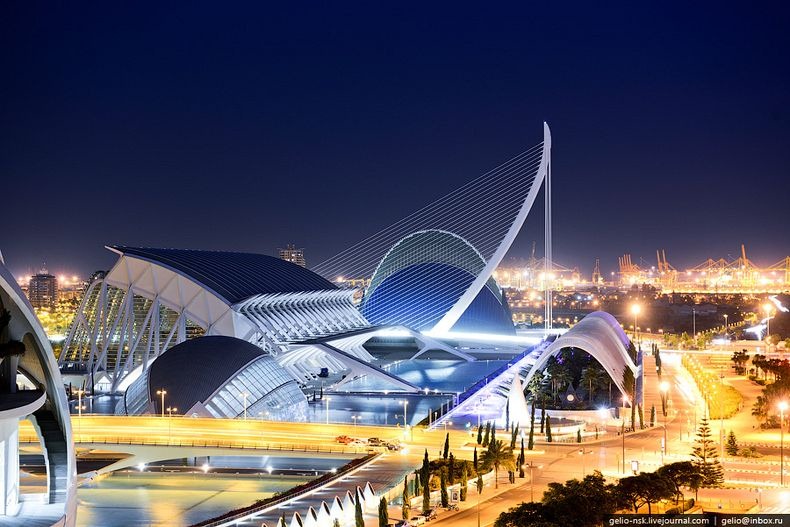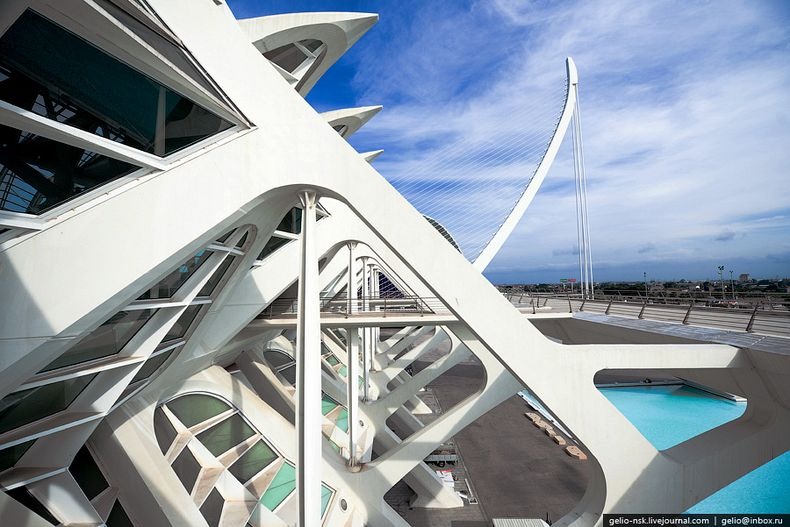The City of Arts and Sciences is a large-scale urban recreation center for culture and science in the city of Valencia, Spain. Designed by Valencian architect Santiago Calatrava and started in July 1996, it is an impressive example of modern architecture. Set in the old dried-up river bed of the Turia, midway between the old city of Valencia and the coastal district of Nazaret, the City of Arts and Sciences covers an area of 350,000 square meters. Following a disastrous flood in 1957, the river was diverted along a canal to the south of the city, and the dried-out riverbed turned into a picturesque sunken park, which is the City of Arts and Sciences. Surrounded by attractive streams and pools of water, the “city” and the surrounding areas are typically used as a relaxing place to walk day or night. It is turning out to be the most important modern tourist destination in the city of Valencia.
The complex was designed almost entirely by Valencia born Santiago Calatrava. L’Hemisfèric, the planetarium, was the first element to be opened to the public in April 1998. The building is meant to resemble a giant eye with an eyelid that opens to access the surrounding water pool. The bottom of the pool is glass, creating the illusion of the eye as a whole. L’Hemisfèric is the centerpiece of the City of Arts and Sciences.
The Science Museum Principe Felipe, opened in 2000, resembles the skeleton of a whale. The building is made up of three floors. Much of the ground floor is taken up by a basketball court. The first floor has a beautiful view of the Turia Garden that surrounds it; the second floor hosts “The Legacy of Science” exhibition by the researchers; the third floor is known as the “Chromosome Forest” which shows the sequencing of human DNA.
L'Oceanogràfic is an open-air oceanographic park, the largest oceanographic aquarium in Europe with 110,000 square meters and 42 million liters of water. It was built in the shape of a water lily and is the work of architect Félix Candela. This aquarium is a home to over 500 different species including dolphins, belugas, sawfish, jellyfish, starfish, sea urchins, walruses, sea lions, seals, penguins, turtles, sharks,and rays. It also inhabits wetland bird species.
El Palau de les Arts Reina Sofia is an opera house and performing arts center, and the last great component of the City of Arts and Sciences. It was presented on October 9, 2005, Valencian Community Day. Calatrava’s use of pure white concrete and Gaudiesque fragments of shattered tiles, an important Valencian industry, tie all the structures together as a whole.
The complex was designed almost entirely by Valencia born Santiago Calatrava. L’Hemisfèric, the planetarium, was the first element to be opened to the public in April 1998. The building is meant to resemble a giant eye with an eyelid that opens to access the surrounding water pool. The bottom of the pool is glass, creating the illusion of the eye as a whole. L’Hemisfèric is the centerpiece of the City of Arts and Sciences.
The Science Museum Principe Felipe, opened in 2000, resembles the skeleton of a whale. The building is made up of three floors. Much of the ground floor is taken up by a basketball court. The first floor has a beautiful view of the Turia Garden that surrounds it; the second floor hosts “The Legacy of Science” exhibition by the researchers; the third floor is known as the “Chromosome Forest” which shows the sequencing of human DNA.
L'Oceanogràfic is an open-air oceanographic park, the largest oceanographic aquarium in Europe with 110,000 square meters and 42 million liters of water. It was built in the shape of a water lily and is the work of architect Félix Candela. This aquarium is a home to over 500 different species including dolphins, belugas, sawfish, jellyfish, starfish, sea urchins, walruses, sea lions, seals, penguins, turtles, sharks,and rays. It also inhabits wetland bird species.
El Palau de les Arts Reina Sofia is an opera house and performing arts center, and the last great component of the City of Arts and Sciences. It was presented on October 9, 2005, Valencian Community Day. Calatrava’s use of pure white concrete and Gaudiesque fragments of shattered tiles, an important Valencian industry, tie all the structures together as a whole.




























0 comments:
Post a Comment